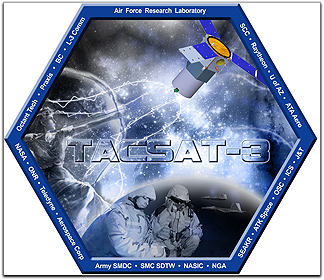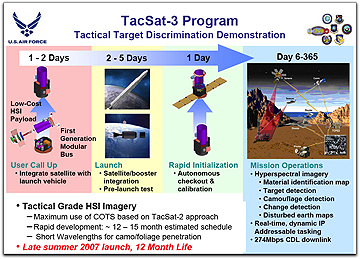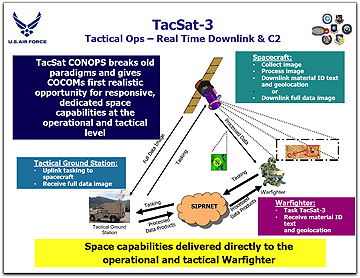 Coming to NASA's Wallops Flight Facility, Wallops Island, Virginia is a first — the Tactical Satellite-3 mission is scheduled to demonstrate rapid data collection and transmission to the combatant commander in the theater of interest.
Coming to NASA's Wallops Flight Facility, Wallops Island, Virginia is a first — the Tactical Satellite-3 mission is scheduled to demonstrate rapid data collection and transmission to the combatant commander in the theater of interest. During this upcoming flight a
new capability will be demonstrated and tested; that of
employing a hyperspectral imager with a space-based, onboard processor to obtain and send images within minutes to the warfighter on the ground. Raytheon constructed the
Advanced Responsive Tactically Effective Military Imaging Spectrometer, or ARTEMIS, hyperspectral imager.

Designated as the satellite's main demonstration, the ARTEMIS hyperspectral imager payload will provide target detection and identification information, as well as battlefield preparation and combat assessment data,
within 10 minutes of its collection. The real element of making this historical is, "The ARTEMIS sensor can identify characteristics by
seeing through camouflage and foliage," said
Thom Davis,
TacSat-3 program manager. "It can also recognize
physical characteristics such as oil and paint. It will also demonstrate its ability to provide real-time information to the warfighter via a text message or on a laptop computer. With the data supplied by the spacecraft, the commander in the theater of interest can determine if the object is something to be concerned about or a decoy."

A second payload representing the Office of Naval Research's satellite communications package, will employ
sea-based buoys as data sites. The Satellite Communications Package experiment will collect information from the ocean equipment and transmit it to a ground station as another communicative tool to enhance the warfighter's ability to stay ahead of an adversary.

The satellite's third payload - Air Force Research Laboratory's space avionics experiment will involve
plug-and-play avionics, which features
reprogrammable parts to link the payload and the satellite structure.
The TacSat-3 spacecraft is a pioneer of the emerging operationally responsive space program, and meets the needs of U.S. forces for flexible, affordable and responsive satellite systems. The TacSat-3 program is a joint effort of the
Army Space and Missile Defense Command, Air Force Space Command, the Department of Defense's Operationally Responsive Space Office, the Office of Naval Research, and
AFRL's Space Vehicles Directorate at Kirtland AFB. The
$55 million program has accomplished all key milestones to date, but the weeks leading up to the launch will be critical. All three payloads have been delivered to AFRL Space Vehicles Directorate, Kirtland Air Force Base, New Mexico, and integrated with the ATK Space Systems-developed modular bus. TacSat-3 has also completed system level performance testing, and by the end of August, will be space qualified after accomplishing shock, vibration and thermal vacuum evaluations. AFRL will then ship the spacecraft to the lift off site where it will be mated with the launch vehicle.
As a key team member in the TacSat-3 program, the Space Development and Test Wing, Kirtland AFB, is providing the
Orbital Sciences Corp. Minotaur 1 launch vehicle. The four-stage rocket consists of two structures taken from retired Minuteman intercontinental ballistic missiles and another two stages from
Orbital's Pegasus booster.

